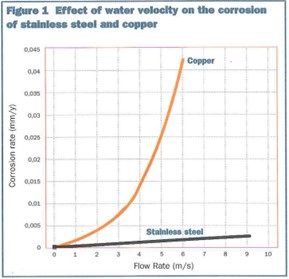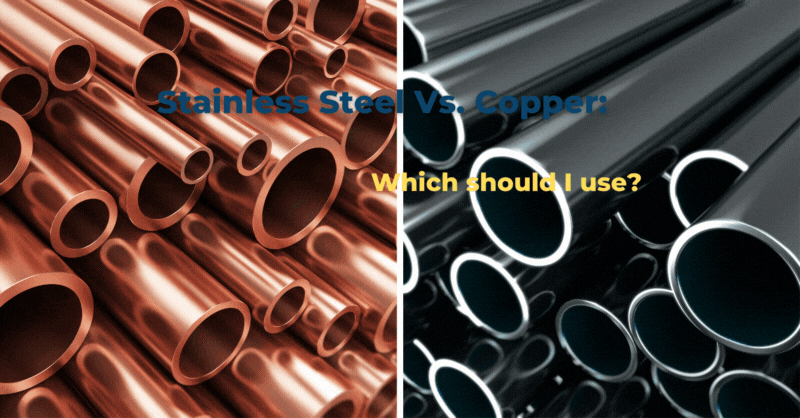Stainless steel vs copper: which should I choose for my pipework?
As New Zealand’s leading supplier of pipeline solutions, customers often ask us “Why should I choose stainless steel pipework over copper?” and, “What are the benefits of stainless-steel vs copper pipework?” In this blog we’ll highlight the strengths and weaknesses of the two piping systems.
When are stainless steel and copper typically used?
Both stainless steel and copper are commonly used and reliable options for pipework. Copper has been used for centuries for domestic, commercial, and light industrial plumbing applications. Stainless steel has historically been viewed as an expensive, premium material and an ‘overkill’ for these applications.
As such, stainless steel piping has traditionally been used more extensively in the food and beverage, and wastewater/water treatment industries, plus heavy industrial applications. Both materials have their advantages, however today; stainless steel is more readily considered for applications where copper piping would have previously been the ‘go-to’ system.
If you’re considering using stainless steel pipe in New Zealand applications instead of copper pipe, here are 13 key qualities and considerations to take into account to help you make an informed decision.
1. Corrosion resistance of stainless steel piping vs copper pipe
Your piping system can suffer from corrosion both internally and externally, and the corrosion resistance of stainless steel pipe is superior to copper pipe for both concerns.
Do copper pipes corrode?
Copper piping systems can corrode externally when exposed to some environmental factors at elevated levels. These include gases such as carbon dioxide, sulphur dioxide, and hydrogen sulphide, along with hard water that’s rich in chlorine, chlorides or a pH outside the 6.5-7 bracket. Acidic environments can cause water discolouration and copper poisoning if it is for human consumption.
Do stainless steel pipes corrode?
Stainless steel piping has very good corrosion resistance. This quality holds in the full range of potable waters, including soft waters. Stainless steel will corrode with high chloride levels but is in general, more corrosion-resistant than copper.
The high level of corrosion resistance in stainless steel comes from a thin, adherent chromium oxide surface film which forms immediately when it comes into contact with oxygen. This sees the pipe surface effectively heal itself if scratched.
In addition to this external surface healing process, piped water supplies contain adequate levels of oxygen to facilitate this healing and protective process inside the stainless steel pipe. The resilience of this chromium oxide layer increases with the presence of molybdenum.
The nickel in stainless steel piping encourages the formation of a crystalline structure called austenite, which aids ductility and formability.
Why does copper turn green?
This is what’s known as oxidation and can occur when copper pipework is exposed to moisture and air. It isn’t harmful, however it is advisable to investigate why the oxidation has occurred as this could point to other problems in the system such as a pinhole leak, faulty join, or dampness in the wall or roof space.
2. Can copper pipe be used for high-velocity applications?
Because the rate of internal corrosion in copper increases significantly as the flow rate increases, copper piping isn’t considered a viable solution for high-velocity applications.
What flow rate is copper pipe suitable for?
At a flow rate of 2 m/s, copper pipe will corrode three times faster than stainless steel pipe. This divide grows exponentially as the flow rate increases, with copper corroding 20 times faster than stainless steel at 6 m/s.
This typically occurs in high-temperature applications where the protective copper oxide layer is softened by the high temperature, then eroded by the water velocity and turbulence. The greater tensile strength of stainless steel gives it a lower susceptibility to internal erosion.
What flow rate is stainless steel pipe suitable for?
Stainless steel piping can withstand water velocities of approximately 30m/s, meaning smaller diameter pipe can be used where suitable.
This is particularly beneficial on variable demand systems where peak demand may only be for very short periods. Here, you can select a pipe size appropriate for standard operation, safe in the knowledge that corrosion resistance will be retained during the higher velocity conditions seen in the short periods of peak demand.
Being able to select a smaller pipe size in these instances can result in attractive capital savings. Selecting a smaller stainless steel pipe size will increase velocity, however, the savings need to be weighed up against any consequent increases in ongoing energy costs required to run the system at a higher velocity.
Acoustic considerations are another potential result of selecting a smaller pipe size and the ramifications should be investigated.

This graph shows the effect of water velocity on the corrosion of stainless steel and copper.
3. Does stainless steel piping require less bracketing?
At scale, the level of bracketing required for piping projects can make a significant difference to material costs and installation timeframes.
Stainless steel doesn’t need as much support as copper because it has a greater tensile strength and is on average 9% less susceptible to thermal expansion. It is calculated to be able to reduce bracketing requirements by up to 40%.
Reducing bracketing is particularly beneficial in commercial plumbing and other building service applications because you have to allow for seismic restraints — a significant cost. Reducing your bracketing requirements can help offset seismic restraint costs and result in big gains in project savings.
Reducing bracketing will likely lead to a saving in labour costs. This is a great way for installers to add value to their design, and is known as value-added engineering. Below is an indication on maximum bracketing distances between Europress stainless steel pipe and copper pipe manufactured to EN 1057 and AS 1432.
|
Nominal pipe Size (mm) |
Europress S/S (m) |
Cu EN 1057 (m) |
Cu AS 1432 (m) |
|
15 |
1.5 |
1.2 |
1.5 |
|
20 |
2.5 |
1.8 |
1.5 |
|
25 |
2.5 |
1.8 |
2.0 |
|
32 |
3.5 |
2.4 |
2.5 |
|
40 |
3.5 |
2.4 |
2.5 |
|
50 |
3.5 |
2.7 |
3.0 |
|
65 |
5.0 |
3.0 |
3.0 |
|
80 |
5.0 |
3.0 |
3.0 |
|
100 |
5.0 |
3.0 |
3.0 |
4. Strength and durability: Is stainless steel pipe stronger than copper pipe?
Stainless steel is on average 2.5 times stronger than copper on strain and stress tests and approximately three times on tensile tests. Our 304L Europress tube has a tensile strength of approximately 650 MPa compared to copper tubing which has a tensile strength of around 280 MPa (Bendable. Annealed is 220 MPa, Hard Drawn is 380 MPa).
Is copper more malleable and easier to cut than stainless steel?
While copper lacks strength, it is more malleable and easier to cut and bend. Annealed 316L pipe can be bent in line with industry best practice, but installers have commented on stainless steel being noticeably harder to cut with a manual cutting tool such as a roller cutter.
There are some ratchet style cutting tools which don’t necessarily cut stainless steel faster but do make it easier and reduce the chance of repetitive strain injury (RSI). Cutter blades tend to wear out quicker when cutting stainless steel versus copper.
What copper gains in malleability, it loses in durability.
Because of the weaker structure of copper it makes the piping more susceptible to damage from external knocks when stored in high foot traffic areas and during installation.
Stainless steel on the other hand, being strong yet ductile, isn't susceptible to the same damage, preserving the integrity of the piping system. Furthermore, stainless steel pipe fittings are stronger making them less susceptible to breakage at what is often the greatest stress point in a piping system.
Because of the strength of stainless steel as a material, you can get away with a thinner pipe wall thickness on your project in order to maintain the same pressure rating when using a smaller external diameter pipe, potentially in the interest of saving on material costs.
Below is a dimensional comparison between copper manufactured to NZS 3501, EN 1057, and AS 1432 and Europress stainless steel showing the outside diameter (OD), internal diameter (ID), and the wall thickness (Wall) with all measurements in mm:
|
NB |
Cu NZS 3501 |
Cu EN 1057 |
Cu AS 1432 |
Europress S/S |
||||||||
|
|
O.D. |
I.D. |
Wall |
O.D. |
I.D. |
Wall |
O.D. |
I.D. |
Wall |
O.D. |
I.D. |
Wall |
|
15 |
14.73 |
12.69 |
1.02 |
15 |
13 |
1 |
12.7 |
10.88 |
0.91 |
15 |
13 |
1 |
|
20 |
21.08 |
19.04 |
1.02 |
22 |
20 |
1 |
19.05 |
17.01 |
1.02 |
22 |
19.6 |
1.2 |
|
25 |
27.43 |
25.39 |
1.02 |
28 |
25 |
1.5 |
25.4 |
22.96 |
1.22 |
28 |
25.6 |
1.2 |
|
32 |
34.19 |
31.75 |
1.22 |
35 |
32 |
1.5 |
31.75 |
29.31 |
1.22 |
35 |
32 |
1.5 |
|
40 |
40.54 |
38.1 |
1.22 |
42 |
39 |
1.5 |
38.1 |
35.66 |
1.22 |
42 |
39 |
1.5 |
|
50 |
53.24 |
50.8 |
1.22 |
54 |
50 |
2 |
50.8 |
48.36 |
1.22 |
54 |
51 |
1.5 |
|
65 |
65.94 |
63.5 |
1.22 |
66.7 |
62.7 |
2 |
63.5 |
61.06 |
1.22 |
76 |
72 |
2 |
|
80 |
79.45 |
76.61 |
1.42 |
76.1 |
72.1 |
2 |
76.2 |
72.94 |
1.63 |
88.9 |
84.9 |
2 |
|
100 |
105.7 |
102.4 |
1.63 |
108 |
103 |
2.5 |
101.6 |
98.34 |
1.63 |
108 |
104 |
2 |
|
125 |
N/A |
N/A |
N/A |
N/A |
N/A |
N/A |
127 |
123.7 |
1.63 |
139.7 |
135.7 |
2 |
|
150 |
156.1 |
152.4 |
1.83 |
N/A |
N/A |
N/A |
152.4 |
148.3 |
2.03 |
168.3 |
164.3 |
2 |
5. Does stainless steel cost more than copper?
The cost of stainless steel as a raw material is more stable than copper. It’s becoming increasingly common for stainless steel pricing to be competitive with copper, especially on the larger sizes, because copper tends to be susceptible to higher cost fluctuations in its raw state.
We have found in the past that the price of Europress stainless steel pipe system was slightly more than copper pipe up to 28mm (the equivalent of 1”/25mm). Then, above 28mm, Europress became more cost-effective than press-fit copper, and increasingly so as the sizes increased.
Research has shown that press-fit copper costs approximately 10% less than stainless steel at 15mm, 19% more at 28mm, 22% more at 54mm, and 24% more at 108mm. Braised copper will typically have a lower cost, however this is offset by its higher installation cost.
6. Is copper pipe suitable for chlorinated water supplies?
Christchurch has been experiencing issues with copper hot water cylinders failing in the thousands since the council began chlorinating the city’s water supply in March 2018. A University of Canterbury study found chlorine (along with other factors) contributed to pitting corrosion inside the copper cylinders.
Plumbers in the garden city who have been replacing the failed copper water cylinders are replacing them with steel units, which are said to be more reliable.
Deeper investigation across the country found a difference in locations where the town or city water supply was from a bore water source or from a surface water source such as a lake or river. Locations which had a surface water supply didn’t have issues with copper, like areas which had a bore water supply. This was particularly an issue when dealing with hot water.
7. Stainless steel pipe vs Copper pipe: which is more sustainable?
Stainless steel is a sustainable material which can be recycled and reused. It has a low carbon footprint because it can be produced without using harmful chemicals. It is also manufactured using a high proportion of recycled material and is 100% recyclable.
Copper is a sustainable material with a low carbon footprint too, but it can cause environmental pollution if not disposed of correctly, e.g., when buried some soils will break copper down, leaching it into the soil.
8. Are there applications where copper can’t be used?
Copper can’t be used in the following applications:
- Pipework carrying diesel fuel – the copper can cause diesel to polymerise and thicken.
- High-pressure systems – the pressure rating of copper pipe reduces dramatically as the size increases.
- High-velocity systems can’t use copper pipe due to the risk of corrosion, which increases as flow rate increases.
9. Does stainless steel offer improved heat retention?
Thermal conductivity is how fast heat will travel outward through the diameter of a piping material. For example, if you are running a copper hot water line into a factory you may need to have a higher input temperature to ensure you get the correct output temperature because the heat loss through a copper line will be higher.
Heat will transfer (and be lost) a lot faster through copper piping, which means insulation is a lot more important to prevent heat loss and related increases in heating costs. Stainless steel thermal conductivity is 1/25th that of copper.
This means stainless steel requires less insulation measures, reducing insulation material and installation costs.
10. Stainless steel needs chloride-free insulation
It’s been proven that stainless steel is susceptible to deterioration from high concentrations of chlorides, particularly in applications over 60°C. This makes selecting the correct insulation very important as some brands of insulation contain chlorides.
When selecting an insulation for stainless steel pipework, it’s recommended that you choose one which is free from chloride. Like stainless steel, copper is also susceptible to deterioration from high concentrations of chlorides in insulation.
11. Bore Smoothness: is stainless steel superior to copper?
Stainless steel piping has a smoother bore or lower roughness factor, making it less susceptible to the growth of bacteria than copper piping.
Not only does copper have higher frictional loss from this roughness factor, it is also more susceptible to bacteria growth which means higher levels of water treatment are required.
12. Connecting copper with plastic piping systems
Deterioration or even failure has occurred in plastic piping systems when connected to a copper system resulting from copper leaching — especially on high temperature and high-velocity applications. This can cause extensive damage to the plastic piping, in some situations creating terminal pin-holing damage in the plastic.
Given stainless steel is less susceptible to erosion from high velocity and high temperatures, there is no risk of leaching and subsequent damage to connecting plastic pipework.
13. Can you connect stainless steel pipe with copper pipe?
There’s a wide school of opinions on this topic. Copper is a non-ferrous material, so, if designed correctly it is ok to connect stainless steel and copper piping.
However, if the system is running at high temperatures or high velocity, or if the water quality is poor; copper leaching can occur. This needs to be considered on a project-by-project basis.
If you decide stainless steel is the right fit for your next project, browse our range of Europress stainless steel piping system products. The comprehensive range features stainless steel tube, stainless steel pipe fittings, brackets, valves, seals, flanges and stainless steel pipe tools.



%20(1).png?width=352&name=Copy%20of%20WW%20%20Blog%20headers%202023%20(27)%20(1).png)
.png?width=352&name=Waterworks%20%20Europress%20compressed%20air%20email%20graphic%20(1).png)
%20(1).png?width=352&name=Waterworks%20%20Press-fit%20vs%20Welding%20email%20graphic%20(1)%20(1).png)